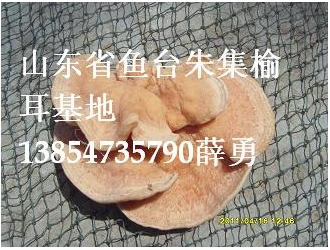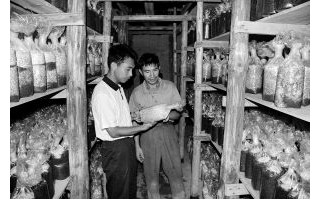抗冷凍蛋白基因遺傳轉(zhuǎn)化草菇的研究
Transformation of Volvariella volvacea with a thermal hysteresis protein gene by particle bombardment
郭麗瓊 林俊芳 熊盛 陳守才
摘 要:采用RT-PCR技術(shù)從瑞典的北極云杉卷葉蛾幼蟲中擴(kuò)增出抗冷凍蛋白基因,利用基因槍法遺傳轉(zhuǎn)化草菇.PCR檢測(cè)和Southem雜交結(jié)果證明,抗冷凍蛋白基因已整合進(jìn)草菇基因組.低溫脅迫試驗(yàn)結(jié)果表明,轉(zhuǎn)基因草菇具有較強(qiáng)的耐低溫能力.轉(zhuǎn)基因草菇生物學(xué)特性觀測(cè)結(jié)果顯示,大多數(shù)草菇轉(zhuǎn)化子的生長(zhǎng)速率明顯地慢于對(duì)照的宿主菌株,多數(shù)轉(zhuǎn)化子的菌絲也明顯地比宿主菌絲細(xì)弱.轉(zhuǎn)化子篩選結(jié)果表明,采用三輪的轉(zhuǎn)化子篩選程序,即第一輪在固體培養(yǎng)基上篩選、第二輪和第三輪在液體培養(yǎng)基中篩選,有利于獲得真實(shí)轉(zhuǎn)化子和淘汰假轉(zhuǎn)化子.轉(zhuǎn)基因草菇一代低溫脅迫結(jié)果證明,轉(zhuǎn)基因草菇后代仍然具有較強(qiáng)的低溫耐受能力,這說明轉(zhuǎn)基因草菇的耐低溫性能在世代之間是穩(wěn)定的.
關(guān)鍵詞:草菇,抗冷凍蛋白基因,轉(zhuǎn)化,基因槍法
分類號(hào):S66.13,Q939.96 文獻(xiàn)標(biāo)識(shí)碼:A
文章編號(hào):0001-6209(2005)01-0039-05
基金項(xiàng)目:國(guó)家自然科學(xué)基金(39960050,30060054,30371000);廣東省自然科學(xué)基金(032239);華南農(nóng)業(yè)大學(xué)校長(zhǎng)基金(5100-K03003)
作者簡(jiǎn)介:郭麗瓊(1963-),女,福州市人,副研究員,博士,主要從事大型真菌分子生物學(xué)和生物技術(shù)研究.E-mail:guolq@scau.edu.cn.林俊芳,通訊作者.Tel:86-20-38902762;Fax:86-20-85280270;E-mail:linjf@scau.edu.cn
作者單位:郭麗瓊(華南農(nóng)業(yè)大學(xué)食品學(xué)院,生物工程系,廣州,510640;中國(guó)熱帶農(nóng)業(yè)科學(xué)院,熱帶作物生物技術(shù)國(guó)家重點(diǎn)實(shí)驗(yàn)室,???571101)
林俊芳(華南農(nóng)業(yè)大學(xué)食品學(xué)院,生物工程系,廣州,510640;中國(guó)熱帶農(nóng)業(yè)科學(xué)院,熱帶作物生物技術(shù)國(guó)家重點(diǎn)實(shí)驗(yàn)室,海口,571101)
熊盛(中國(guó)熱帶農(nóng)業(yè)科學(xué)院,熱帶作物生物技術(shù)國(guó)家重點(diǎn)實(shí)驗(yàn)室,???571101)
陳守才(中國(guó)熱帶農(nóng)業(yè)科學(xué)院,熱帶作物生物技術(shù)國(guó)家重點(diǎn)實(shí)驗(yàn)室,海口,571101)
參考文獻(xiàn):
[1]Chang S T. The Biology and Cultivation of Edible Fungi. New York: Academic Press, 1978, 573- 605.
[2]謝寶貴,黃志龍,江玉姬.草菇雜交研究初報(bào).食用菌學(xué)報(bào),1997,4(2):5-10.
[3]Barrett J. Thermal hysteresis proteins. The International Journal of Biochemistry & Cell Biology, 2001, 33:105- 117.
[4]Raeder U, Broda P. Rapid preparation of DNA from filamentous fungi. Letter of Applied Microbiology, 1985, 1:17 - 20.
[5]Sambrook J,Fritsch E F,Maniatis T.分子克隆實(shí)驗(yàn)指南.金冬雁,黎孟楓,等譯.第二版.北京:科學(xué)出版社,1992.
[6]Jia J H, Buswell J A, Peberdy J F. Transformation of the edible fungi, Pleurotus ostrentus and Volvariella volvacea. Mycological Research, 1998, 102(7) :876 - 880.
[7]Rhee M D V D, Graca P M A, Huizing H J, et al. Transformation of the cultivated mushroom, Agaricus bisporus, to hygromycin B resistance. Molecular and General Genetics, 1996, 250:252- 258.
[8]Sato T, Yaegashi K, Ishii S, et al. Transformation of the edible basidiomycete Lentinus edodes by restriction enzyme-mediated integration of plasmid DNA. Bioscience Biotechnology and Biochemistry, 1998, 62(12) :2346 - 2350.
[9]Virgin J B, Bailey J P. The M26 hotspot of Schizosaccharomyces pomb stimulates meiotic ectopic recombination and chromosomal rearrangements. Genetics, 1998, 149(3): 1191 - 1204.
[10]Cormack B P, Falkow S. Efficient homologous and illegitimate recombination in the opportunistic yeast pathogen Candida glabrata.Genetics, 1999, 151(3) :979 - 987.
[11]Prudhomme M, Libante V, Claverys J P. Homologous recombination at the border: Insertion-deletions and the trapping of foreign DNA in Streptococcus pneumoniae. Proceedings of the National Academy of Sciences of USA, 2002, 99(4):2100-2105.
[12]Urawa H, Hidaka M, Ishignro S, et al. Enhanced homologous recombination caused by the non-transcribed spacer of the rDNA in Arabidopsis . Molecular Genetics and Genomics , 2001, 266(4):546- 555.
[13]Kohli A, Leech M, Vain P, et al. Transgene organization in rice engineered through direct DNA transfer supports a two-phase integration mechanism mediated by the establishment of integration hot spots. Proceedings of the National Academy of Sciences of USA,1998, 95:7203 - 7208.
[14]Holmberg N, Lilius G, Bulow L. Artificial antifreeze proteins can improve Naes tolerance when expressed in E. coli. FEBS Letters, 1994, 349(3) :354 - 358.
[15]Rubinsky B, Mattioli M, Arav A, et al. Inhibition of Ca2+ and K +currents by antifreeze proteins. The American Journal of Physiology,1992, 262:542 - 545.
微生物學(xué)報(bào)
ACTA MICROBIOLOGICA SINICA
2005 Vol.45 No.1 P.39-43






